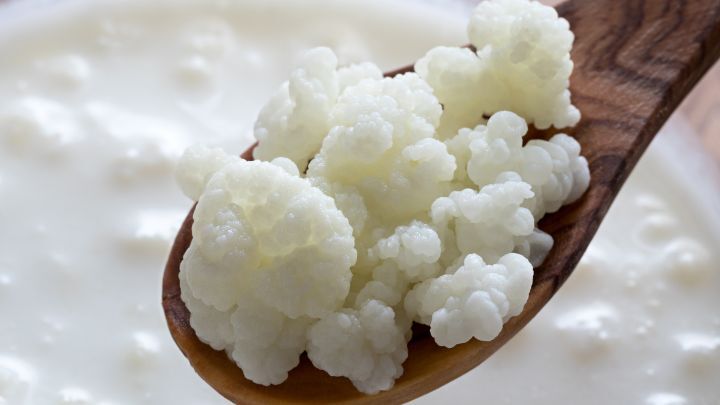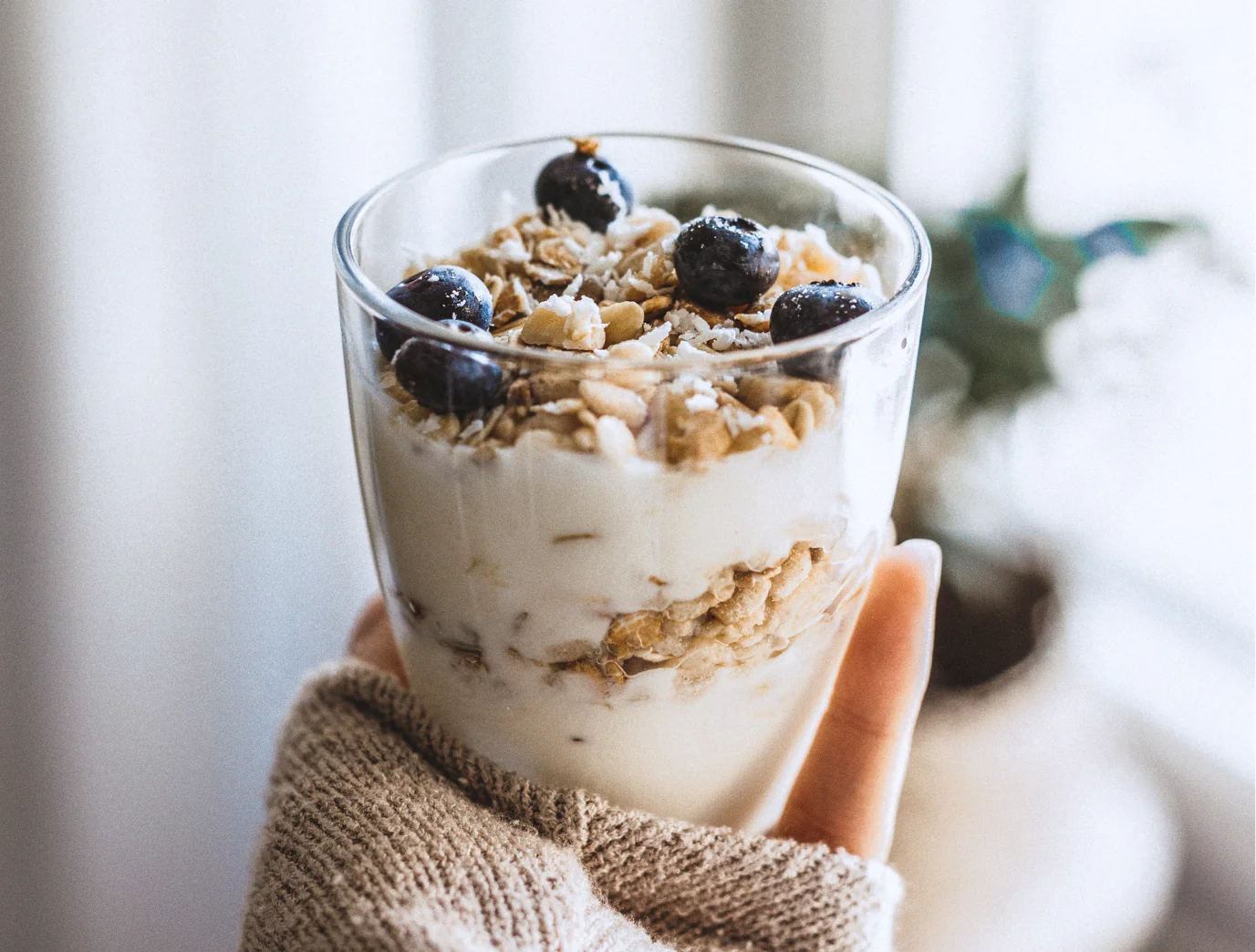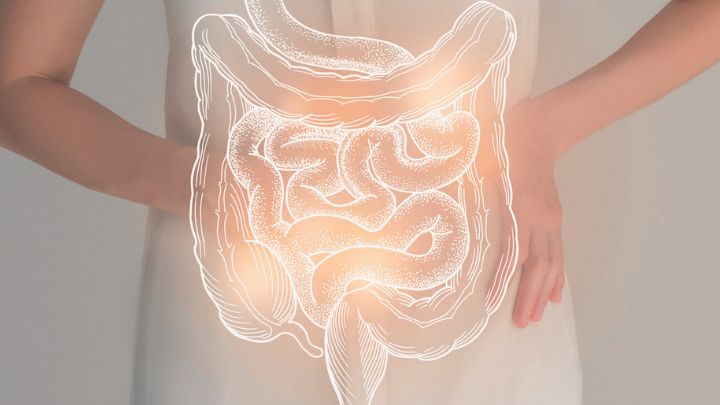Over the past few decades, our diets and lifestyles have dramatically changed. More processed foods, more sedentary habits, more stress. Ever considered the strain this puts on your body?
Your gut health might be suffering the most, and you might not even know about it.
When your gut’s balance of good bacteria is disrupted, a condition called dysbiosis (one of the 12 hallmarks of ageing) may occur. This can lead to gas, diarrhoea, constipation, and even serious conditions like heart disease and immune problems.
Probiotics can help restore this balance, acting as your gut’s personal trainers.
When it comes to kefir v.s. kombucha, which probiotic powerhouse is your go-to?
Think of them as the Michael Phelps and Usain Bolt of the probiotic world. Just like these Olympic champions, kefir and kombucha each bring unique strengths to the table.
In this Avea article, we explore the origins, health benefits, and unique qualities of these probiotics.
By the end, you’ll know everything you need to pick your favourite and start improving your gut health as soon as possible. So, let the games begin!
In this article
Free guide to reverse your biological age

- Master the science of rejuvenation.
- Apply proven tips to turn back the clock.
- Transform your health with top longevity specialists.
History of kefir
Kefir’s origins remain a mystery, but let’s journey back to the Caucasus region, where the earliest records of this tangy drink are found.
Picture ancient Eastern nomadic shepherds, trudging along with their leather pouches of milk, magically transforming into a frothy beverage during their travels.
They called it “kefir,” derived from the Turkish word “keyif,” meaning “joy” or “pleasure.” And why not? Who wouldn’t be delighted by unexpectedly discovering a delicious new drink while on the move (pun intended).
Some even credit the Prophet Muhammad for gifting kefir grains to the people of the northern Caucasus. According to them, these precious grains were to be passed down through generations like a sacred family heirloom.
Known by many names worldwide—kefyr, kephir, kefer, kiaphur, knapon, kepi, and kippi—kefir has more aliases than a secret agent, and this time, for very fair reasons.
History of kombucha
Now, let’s hop over to East Asia, the birthplace of kombucha. This fizzy, fermented tea was adored in China for its energising and detoxifying powers and was dubbed “Divine Che.”
The legend goes that a physician named Kombu used this magical tea (“cha” in Japanese) to cure Emperor Inkyo, and thus, it became known as “Kombu’s tea” or kombucha.
From Japan, this ‘’magic potion’’ spread to Russia, where it was called “Tea Kvass,” and eventually made its way to Europe and Africa.
Today, kombucha is a global sensation, enjoyed by health enthusiasts everywhere.
What is kefir?
Kefir is a fermented, slightly fizzy drink. The fermentation process happens thanks to a natural mix of microorganisms found in the polysaccharide matrix of kefir grains.
Kefir grains are a symbiotic blend of yeasts, lactic acid bacteria, and acetic acid bacteria. They range in size from 0.5 to 3.5 cm, have an irregular shape, and are usually yellowish or whitish.
The microbial makeup of kefir grains can vary depending on
- where they come from
- the ingredients used to grow them
- the methods used in their production
This diversity is what makes kefir unique and full of health benefits.
Research by Tavares and others has shown that kefir contains a wide variety of microorganisms. Using advanced molecular techniques, they found four types of bacteria and four types of yeasts in kefir.
For the health nerds, some of the main bacteria include Lactobacillus, Lacticaseibacillus, Lentilactobacillus, Leuconostoc, and Acetobacter. The yeasts commonly found in kefir are Saccharomyces, Kluyveromyces, Lachancea, and Kazachstania.
How kefir is made?
So, how do you make kefir? Kefir is made by fermenting milk with kefir grains.
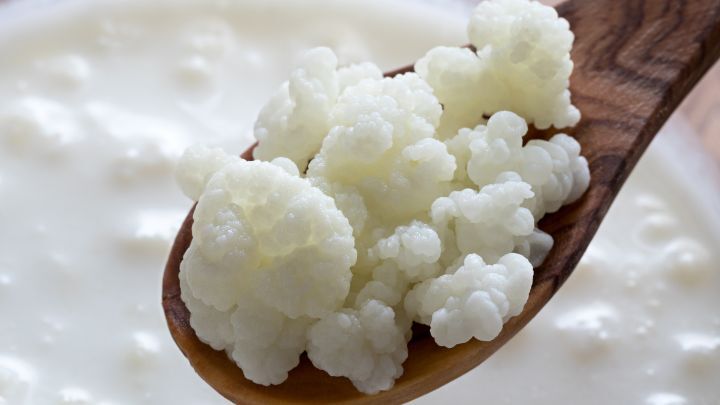
After fermentation, the milk is filtered, and the kefir grains are reused for the next batch. Adjusting fermentation conditions and the grain-to-milk ratio can significantly influence the properties of the kefir.
Traditionally, kefir is made using pasteurised or UHT (ultra-high-temperature) treated milk or a brown sugar solution.
But, being highly versatile, kefir grains can also ferment different types of substrates such as cow, goat, sheep, and buffalo milk, as well as fruit juices, soy extract, vegetables, and cereals.
During fermentation, the microorganisms in kefir grains undergo three types of fermentation: lactic, alcoholic, and acetic.
This process typically takes 24–48 hours. The result is a kefir beverage that is ready to drink, packed with probiotics that promote gut health.
The adaptability of kefir grains allows for the creation of new formulations and beverages, catering to different tastes and dietary needs.
Age backwards by 24 years like Dave Pascoe

- Learn the science that helped Dave enter his 60s with a biological age of less than 40.
- Apply proven longevity strategies to transform your own health.
- Implement expert tips for lasting youthfulness.
What is kombucha?
Kombucha is a fermented beverage made by fermenting black, oolong, or green tea varieties of Camellia sinensis with sugar and a symbiotic culture of bacteria and yeast known as SCOBY (Symbiotic Culture of Bacteria and Yeast).
This process also creates a tangy, slightly fizzy drink packed with probiotics, which can offer numerous health benefits.
The SCOBY used in kombucha contains a variety of microorganisms, including acetic acid bacteria (such as Acetobacter spp., Gluconobacter spp., and Komagataeibacter spp.), lactic acid bacteria (like Lactococcus spp. and Lactobacillus spp.), and several types of yeasts (including Brettanomyces spp., Kloeckera spp., Saccharomyces spp., Saccharomycodes spp., Schizosaccharomyces spp., Torulaspora spp., and Zygosaccharomyces spp.).
This diverse microbial community interacts within the liquid environment to produce the beneficial properties of kombucha.
How kombucha is made?
Kombucha is typically fermented over a period of 7–12 days at room temperature in a static fermentation process.
The characteristics of the final beverage, such as taste and texture, can vary based on factors like temperature and fermentation time.

During fermentation, the microorganisms from the SCOBY are distributed in two categories: those that become part of the cellulose biofilm and those that remain in the liquid. This dual presence is essential for the unique properties of kombucha.
To make kombucha, the SCOBY is added to sweetened tea and left to ferment for about a week. After this initial fermentation, the beverage can either be consumed as is or undergo a second fermentation with added fruits or vegetable pulps to enhance flavour and probiotic content.
Just like kefir, kombucha’s ability to ferment in various conditions and adapt to different substrates, allows for a wide range of flavours and formulations, catering to diverse preferences and dietary needs.
What is kefir good for?
1. Is kefir good for my immune system?
Probiotic microorganisms in kefir have been studied for their impact on the immune system for quite some time.
Various studies (especially those involving lactic acid bacteria, as present in kefir) have shown that probiotics can stimulate the immune system in both animals and humans.
The exact mechanisms are still being uncovered, but it’s believed that probiotics interact with Peyer’s patches and intestinal epithelial cells, which in turn stimulate IgA-producing B cells and T cell migration from the gut.
In a nutshell, regular consumption of probiotics can boost macrophage activity, which in turn boosts your immune system.
Certain Lactobacillus strains, like Lactobacillus reuteri and Lactobacillus brevis, have shown promise in immunotherapy, including oral vaccines that help induce T cell tolerance against autoimmune diseases.
These probiotics can increase the expression of pro-inflammatory cytokines, helping to modulate the immune response and improve overall immune health.
2. Is kefir good for cancer?
Kefir has shown some impressive antitumor and anticancer properties in various animal studies, but human studies are still lacking.
For instance, a water-soluble polysaccharide from kefir grains was found to inhibit the growth of Ehrlich carcinoma in mice.
Another study demonstrated that feeding mice kefir grains significantly inhibited tumour growth of Lewis lung carcinoma.
Further research showed that kefir beverages made from cow’s milk, soy milk, and milk could inhibit tumour growth by about 65-71% in mice inoculated with sarcoma-180 tumour cells.
Regular consumption of kefir also reduced the incidence of pre-neoplastic colonic lesions in rats by 36%, likely due to increased production of short-chain fatty acids, improved intestinal permeability, and enhanced antioxidant activity in the colon.
3. Does kefir have antimicrobial activity?
Kefir’s main claim to fame is its ability to improve gut health by modulating the gut microbiota.
It reduces harmful microorganisms whilst increasing beneficial ones like Lactobacillus spp. and Bifidobacterium spp.
Kefir contains antimicrobial substances such as lactic acid, acetic acid, and hydrogen peroxide (H2O2), which are known to kill or inhibit the growth of pathogens.
For example, lactic acid lowers the pH of your gut, making it inhospitable for harmful bacteria, while H2O2 and acetic acid have direct antibacterial effects.
Kefir has been shown to inhibit a range of pathogens, including Salmonella spp., Yersinia spp., Shigella spp., Micrococcus spp., Escherichia coli, Bacillus cereus, Candida albicans, and Klebsiella pneumoniae.
In one study, kefir was even effective against Staphylococcus aureus, Pseudomonas fluorescens, Escherichia coli, and Bacillus subtilis, all known to cause gastrointestinal diseases.
Both kefir and kefiran (a polysaccharide from kefir) have demonstrated antibacterial activity against various pathogens, with the highest activity noted against Streptococcus pyogenes.
Experience Avea’s next-gen probiotic supplement
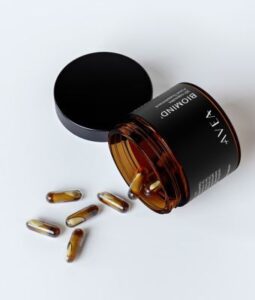
- 4x probiotic survival: Advanced Duocap® technology
- Targeted gut-brain support: Panax Ginseng, 10 strains (30Bn CFUs), Vitamin B6 & B12
- Backed by science: 1000+ studies
What is Kombucha good for?
1. Is kombucha good for my immune system?
Kombucha isn’t just Instagram-worthy. It’s a powerful immunomodulator supported by many recent scientific studies.
Zubaidah et al. found black tea kombucha helps mice combat Salmonella typhi due to its phenolic compounds and organic acids.
Sknepnek et al. combined kombucha with medicinal mushrooms, creating a supercharged drink that may apparently prevent allergies, asthma, and dermatitis. Their study also suggests kombucha to boost immune defence against viruses.
Another study showed oak-made kombucha helps reduce inflammation and oxidative stress, making it a potent health ally.
2. Is kombucha good for cancer?
Kombucha’s anticarcinogenic potential is also noteworthy. Ziska et al. studied kombucha’s effects on breast cancer cells, but didn’t find significant results.
However, Ghodousi Dehnavi et al. found that kombucha fractions inhibited the growth of HT-29 colon cancer cells in a dose-dependent manner, causing cell death through apoptosis.
Another study focused on kombucha made from different teas (green, oolong, and black) and found it effective against colorectal cancer cells.
The green and black tea kombucha showed significant toxicity against these cancer cells, demonstrating kombucha’s potential as a cancer-fighting agent.
3. Does Kombucha have antimicrobial activity?
Kombucha’s antimicrobial properties have been studied extensively.
Despite its homemade origins, which could suggest a breeding ground for contaminants, kombucha generally remains free from harmful pathogens. This is likely due to its high acidity and alcohol content.
Laurenson et al. demonstrated kombucha’s ability to eliminate Escherichia coli in dairy effluent, reducing E. coli colonies to undetectable levels within 48 hours. This shows kombucha’s potential for environmental uses.
In a Brazilian hospital study, Santos Júnior et al. found that fermented kombucha effectively inhibited Microsporum canis, Escherichia coli, and Salmonella typhi. The best results were seen under specific conditions, like pH 4.0 and the presence of certain minerals and sugars.
Battikh et al. compared the antimicrobial activities of green and black tea kombucha. Both showed strong antibacterial and antifungal properties, especially against harmful bacteria like Staphylococcus epidermidis, Listeria monocytogenes, and Micrococcus luteus. Green tea kombucha can also protect against Candida yeast infections.
Another study by Kaewkod et al., explored kombucha made from different teas and found it could inhibit pathogenic enteric bacteria like E. coli, Shigella dysenteriae, Salmonella typhi, and Vibrio cholera.
How science improved the process of making kefir
1. Spray drying and lyophilization
Atalar and Dervisoglu have explored the spray drying process to create kefir powder using response surface methodology (RSM).
This method optimises the parameters for producing kefir powder, offering a convenient option for those who prefer an easy, quick-to-consume product without having to cultivate kefir grains.
Their study, combined with lyophilization results, showed that high-quality kefir could be obtained in a lyophilized form.
Teijeiro et al. further validated this approach, assessing the survival of microorganisms after drying, storage, and simulated gastrointestinal conditions.
They concluded that spray drying is effective for producing a concentrated kefir product that retains viable and active microorganisms, facilitating better storage and transportation.
2. Nanoencapsulation
Yilmaz et al. took a different approach by encapsulating probiotics within alginate nanofibres through electrospinning.
This method significantly improved the survival of the Lactobacillus paracasei KS-199 strain, isolated from kefir, under simulated gastric juice and gut conditions.
The nanoencapsulation of probiotics enhanced their viability, as they passed through the stomach and colonised the gut.
Alginate, a biopolymer, proved essential for protecting and increasing the viability of probiotics during their journey through the digestive system.
How science improved the process of making kombucha
1. Heat treatments for storage
Jayabalan et al. investigated the use of heat treatments to extend the shelf life of kombucha and prevent biofilm formation in the final product.
They found that heating kombucha tea at 60, 65, and 68°C for one minute effectively controlled biofilm formation without affecting the tea’s clarity or flavour.
However, the polyphenol content and quality parameters of black tea varied during storage, indicating that heat treatment might not be the best preservation method for kombucha.
2. Encapsulated kombucha starter culture for bread
Roby et al. explored the use of encapsulated kombucha starter culture in fermented dough bread, eliminating the need for baker’s yeast.
Their principal component analysis revealed the presence of 15 metabolites in the kombucha-fermented dough.
The kombucha starter increased bread volume, extended shelf life by 5 to 10 days at room temperature, and enhanced flavour and overall acceptability.
This innovative approach suggests that encapsulated kombucha starter culture could produce functional yeast dough bread with a longer shelf life and improved quality.
What’s the consensus on kefir and kombucha?
So, you’ve learnt about kefir and kombucha. But what’s the current scientific consensus?
They have both been credited with anti-inflammatory, antibacterial, anticarcinogenic, antimicrobial, antioxidant, and anti-proliferative properties, as well as potential benefits for mental health.
But, whilst these benefits are impressive on paper, they mostly stem from preliminary studies, and many have yet to be conclusively proven in human clinical trials.
The promise lies in future research, which will hopefully provide the scientific validation needed for these health claims.
Side effects of kefir and kombucha
Despite their potential, there are limitations to the consumption of kefir and kombucha. If not prepared correctly, these cultures can be harmful.
People with pre-existing conditions might find them intolerable due to their acidic nature, stemming from acetic and lactic acids. This acidic pH can be problematic for those with stomach disorders.
Research is ongoing, particularly in areas such as stomach health, skin conditions, lactose intolerance, hyperlipidemia, and sensorimotor behaviour.
Safety concerns primarily revolve around contamination, often due to
- unreliable raw materials
- inadequate fermentation vessels
- improper packaging
- poor sanitation, during the fermentation process.
Contaminated cultures can expose consumers to undesirable metabolites and harmful microorganisms.
To mitigate these risks, health organisations should develop protocols and standards to ensure safe production methods, high-quality raw materials, and rigorous quality control.
Kefir v.s. kombucha: which one is a better probiotic?
Researchers conducted a thorough review to compare the benefits of kefir and kombucha, analysing data from multiple online databases up to January 2024. This article is a summary of the review [1].
This study still has its limitations. The databases and languages chosen—primarily English, Portuguese, and Spanish—reflect the authors’ regions of residence and the universal acceptance of English in scientific publications.
While these databases provide a substantial portion of the global literature, they do not cover every scientific source available worldwide. Future studies should consider incorporating additional databases and languages to offer a more comprehensive view.
Regardless, kefir and kombucha are both powerful probiotics with unique benefits. You can’t compare them, just like you would not compare Kim Yeji: South Korea’s coolest sharpshooter with Yuto Horigome: Japan’s top skateboarder.
Both Kim Yeji and Yuto Horigome brought their unique skills (or should we say, aura) to the Paris Olympics 2024, each taking home well-deserved medals.
In the end, choosing between kefir and kombucha depends on your personal health needs and taste preferences. Incorporating either or both into your diet can support your gut health and overall well-being.
Remember to be cautious of products loaded with sugar, as they can reduce the overall effectiveness of the probiotics.
References












